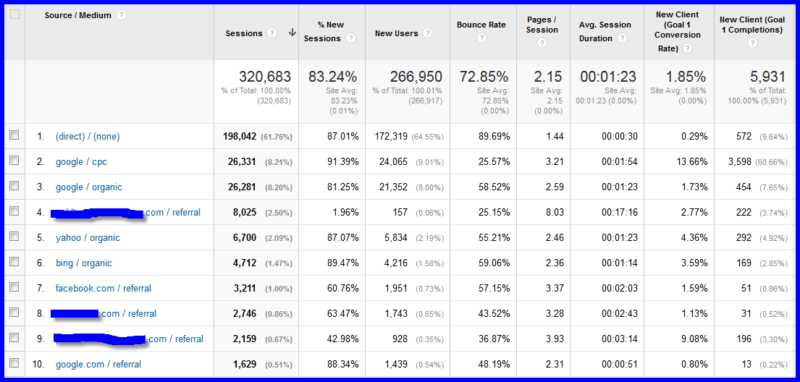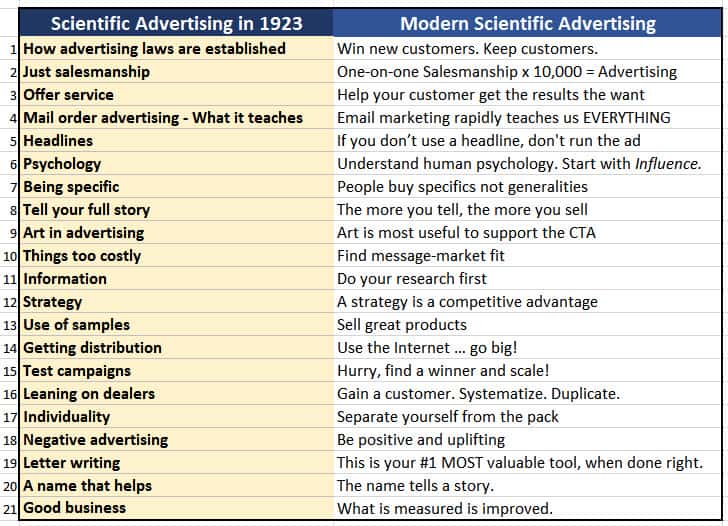The Ultimate Marketing Plan Checklist PDF (Free download)
Marketing is undoubtedly the best way to grow a business. A solid marketing strategy can transform your business and turn […]
Read More »Become a successful marketing consultant: Learn more

This #shorts video is best viewed on mobile:
Scientific Advertising isn't just a term first coined in 1923.
Little did advertiser Claude Hopkins know at the time, 100 years ago, that his book of the same title:
would have a much larger data driven meaning because of the Internet.
Scientific advertising definition
Scientific Advertising by Claude Hopkins is a book written in 1923 about new advertising strategies. Today, the term scientific advertising has a larger meaning with advanced technologies giving marketing and advertising much more information from 'big data' in order to make better decisions.
But Hopkins set a foundation for how men & women in marketing and advertising can best communicate value through advertising.
And simultaneously teach methods to make each advertising dollar accountable for itself.
You see, advertising today is much like a collaborative environment. Advertisers worldwide can quickly share their successes and failures using modern scientific advertising tools such as Google Ads, Microsoft Adcenter and Analytics. Tools like these have made it easy for today’s advertiser to compute their sources of customers and quickly calculate a return on advertising costs.

But before we dig into the specifics of creating your own modern scientific advertising strategy…
Claude Hopkins used the term Scientific Advertising to describe methods and technologies he pioneered. Hopkins revealed in his book in 1923 that the science of advertising had evolved to a reasonably exact, fixed set of principles. No longer did an advertiser need to take gambles and there was no more guesswork in advertising. Reliable methodologies learned and acted upon, led advertising to become one of the safest of business ventures.
And they are just as true today as they were then.
In fact, it's never been easier to find winning advertisements quickly. Using today’s tools, finding a profitable ad can sometimes be revealed on the same day. This is in contrast to often waiting months in anticipation of ad tests like advertising of old.
Plus, today, there are more opportunities than ever to scientifically target your message to your customer than at any time in history.
Scientific advertising is a core methodology that all marketing and advertising professionals should be well acquainted with. Especially in today’s data driven economy.
And if you haven’t read Scientific Advertising by Claude Hopkins, you need to. Because it is probably the best book on advertising ever written. Bar none.
So, as we develop your own strategic marketing and advertising plan, let’s define scientific advertising more closely:
Dictionary.com defines “scientific” as being ‘systematic and methodical; the methods and principles of science’.
Merriam-webster.com defines “advertising” as: ‘the action of calling something to the attention of the public, especially by paid announcements.’
Well, let’s start with this:
Using today’s big data systems for bringing attention to a product or service.
And the good news for today’s advertisers is: there are more fantastic tools for advertising than ever before. Sometimes the hardest part is matching the right tools to the project.
Hopkins did a masterful job in laying out the framework for a great advertising plan. With a little updating we can make this plan modern and applicable.
Right now, I am reading my doggy-eared, soiled, note-filled and highlighted 87-page copy of Scientific Advertising by Claude Hopkins. This is probably my 51st reading.
While not all topics are current for today’s fast-moving business environment, all of the 21 chapters are relevant and contain amazing advertising lessons both for veteran and novice advertisers and marketers alike.
Here’s are the chapters of Hopkin’s scientific advertising book that he felt were most important topics to cover, with a modern commentary next to each:

Each of these 21 short, powerful chapters are relevant to business today, just as they were 100 years.
In fact, topics like being specific, the use of psychology, creating individuality, telling your story and testing your campaigns are probably more true today than ever. And implementing these strategies are easier than ever with amazing digital tools such as Wordpress, Shopify and Adobe products.
When you have all of these principles working together in synergy, magic can happen for you, largely for two reasons: 1) These advertising principles work when you work them, and 2) your competition isn’t doing this.
But two specific topics addressed by Hopkins will create more success in your quest for setting up your scientific advertising and marketing systems than virtually all others combined.
These two principles will be the core, not just for our scientific advertising plan, but for your entire marketing plan.
A lot of research and billions of dollars have been invested into defining what is the most important part of an ad. The results are very clear and there is no guesswork here. The most important part of an ad by an enormous amount over other components is:
Direct marketing experts such as Victor Schwab, Claude Hopkins, John Caples, Joseph Sugarman, Ted Nicholas, Sam Hirschberg, MBA and Dan Kennedy have proven this many many times over.
Sadly, many well-meaning and talented art designers, website developers, marketing assistants on and on are guilty of not even using a headline. This is the quickest way to put a blanket over an advertisement. And gaining no return on ad spend.
And, in the case a headline is used, often times it is so general (see Hopkin’s chapter 7) and breaks the rules of human psychology’s reasons for taking action (see Hopkin’s chapter 6), the ad test results become next to worthless (see Hopkin’s chapter 15).
And whether on a print ad, radio ad, landing page, the main site, a postcard, a thank you letter or a product page, many more marketing experts validate the proper use of a headline every single day.
Get out a piece of paper and write down all the reasons why your customer buys your product.
List them out. You might have 5 reasons, 10, 20, or 100.
Don’t just list the specifications such as the 3 horsepower, the ¾ inch drill, the grooved handheld design, or the black and white stripes. Those are features and rarely deserve a top spot in your scientific advertising plan.
But list the real reason why they buy… for the amazing feeling of being lean and trim for good health, for the feeling of a job well done and the pat on their back from their wife, or the new confident bounce in their step they will gain as a result of your product or service.
Remember, no one goes to Home Depot for the power drill. You go to Home Depot so your wife is happy after you hang the beautiful picture of your family sitting on the beach in Maui after a wonderful vacation.
People go to Home Depot to buy the power drill so they can put holes in the wall to hand the awesome photo. Sell this in your headlines. Your return on advertising will thank us for it.
Once you have all your “reasons why” listed, you will have more great headline options than your competitors.
But as important as the headline is, the other part of this equation is:
Delivering the attitude of providing great service to your target market
This is so important to your advertising because, as the saying goes, the people in your target market have one favorite radio station.
They only listen to:
WIIFM: What's in it for me?
You see, your customers are selfish.
They only truly care about themselves and what's most important to them.
This is why your advertising strategy needs to be 100% focused on their needs and how you can serve their needs.
Get this wrong and your advertising will be very difficult to get right.
When done properly, making these time-tested and proven scientific advertising principles core to your overall marketing strategy. Whether you are running print ads, direct mail, specific landing pages, online advertising or on your main site, these principles will put your leap years ahead of your competition.
This awesome strategy is by Sam Hirschberg, MBA. For some great conversations, tips and strategies, follow Sam on Twitter.
Helpful Resources:
If you have special advertising skills, whether big data or graphic design, you can learn how to turn this into an income as a marketing consultant. Go here to learn how with our Nomad Marketing Starter Guide.